Medication Persistence and Health Care Expenditures in a Managed Medicaid Population With Asthma
A retrospective review of administrative claims data was conducted to identify health plan members with asthma who were persistent with their controller medications and those who were not persistent. Utilization of health care services and associated costs were measured for both groups. Non-persistent use of controller medications resulted in more asthma-related emergency department visits and home health services whereas persistent controller use was associated with more physician office and outpatient visits. Mean asthma-related medical costs per member were greater in the non-persistent cohort ($577.62) than in the persistent cohort ($323.03). These findings support the need for targeted interventions to address non-persistence in a managed Medicaid population.(Drug Benefit Trends. 2009;21:112-118)
Asthma affects approximately 22 million persons in the United States, costing an estimated $19.7 billion annually. Of the $14.7 billion in direct costs, $8.5 billion (approximately 60%) is attributed to the cost of hospitalizations and emergency department (ED) visits. Prescription drugs represent the remaining 40% of direct costs or $6.2 billion.1 Persons with asthma have more than 444,000 hospitalizations and 1.7 million ED visits annually. In addition, in 2006, there were 11.8 million outpatient asthma visits to physician offices and hospital outpatient departments.

Although mortality from asthma has declined in recent years, in 2005, there were 3884 deaths due to asthma.2 Much of the morbidity and mortality associated with asthma can be prevented with persistent use of long-term controller medications, such as inhaled corticosteroids. Unfortunately, controller medications are significantly underused, with reports of underuse as high as 73%.3 Nonadherence to effective therapies accounts for approximately 60% of asthma-related hospitalizations,4 with asthma ranked as the third leading cause of preventable hospitalizations in the United States.5
Other factors associated with increased mortality and morbidity related to asthma are lower socioeconomic status, African American race, and residence in urban areas.6 Data suggest children from low-income families have a 40% higher rate of hospitalizations and a 40% lower rate of preventive ambulatory care.7 Studies of Medicaid recipients also report findings of increased hospitalization rates3 and underuse of controller medications.8 Proposed reasons for these disparities include lack of access to quality care, inability to afford care, and cultural and language barriers.3,6 However, findings that suggest lack of access to quality care is the primary contributor to increased morbidity are not conclusive.6
Kentucky, where this study was conducted, has a high prevalence of asthma, smoking (28.2% of the population smokes), and cancer (226.2 cancer deaths per 100,000 population in 2008), and it ranks as having one of the highest rates for utilizing medical services.9 Approximately 16.9% of the population lives in poverty, which is above the national average.10
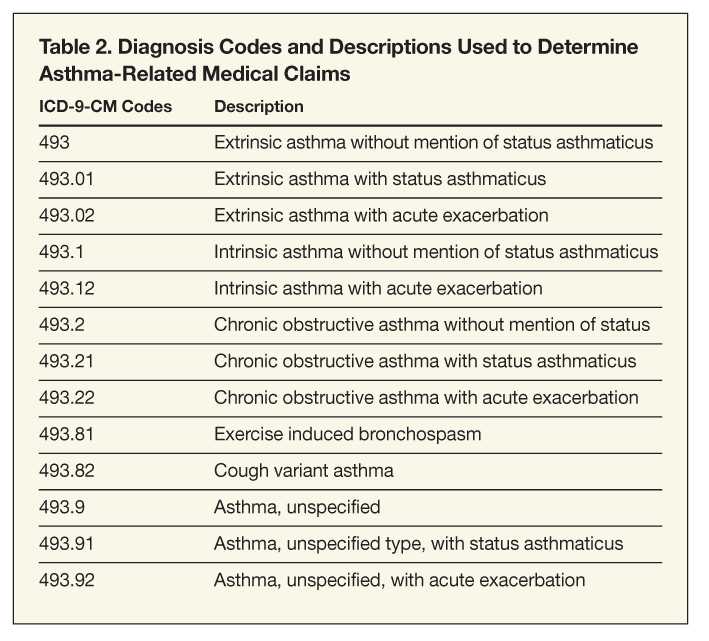
Passport Health Plan is a provider-owned Medicaid Managed Care program serving approximately 21% of the Kentucky Medicaid population. Its 150,483 members are mainly young, female, and low- income, residing in 16 Kentucky counties surrounding the metropolis of Louisville. The objectives of this study were to determine the rate of persistence with asthma controller medications, to identify members non-persistent with asthma controller medications who may benefit from targeted disease management interventions, and to examine the influence of medication persistence on the utilization of health care resources among persons with asthma who are enrolled in a Medicaid managed care plan.
Methods
The study was conducted from October 1, 2007, to February 29, 2008. Study participants were selected among Passport Health Plan members between the ages of 2 and 56 years who were continuously enrolled. Continuous enrollment was defined as enrollment in the health plan 6 months before the start of the study through the end of the study period. A retrospective review of the prescription claims system was conducted to identify members with pharmacy claims for 1 of the asthma controller medications listed in Table 1. To distinguish episodic use of controller therapy from maintenance use, members were required to have used controller medication for at least 3 consecutive months to be included in the study. Validation of asthma was confirmed by reviewing medical claims data for the presence of an ICD-9-coded asthma-related diagnosis (Table 2). Members with a prescription claim for a controller medication for each month of the 5-month study period were considered as persistent with their therapy. Members with fewer than 3 months of continuous controller therapy within the study period were considered as non-persistent (Figure 1).
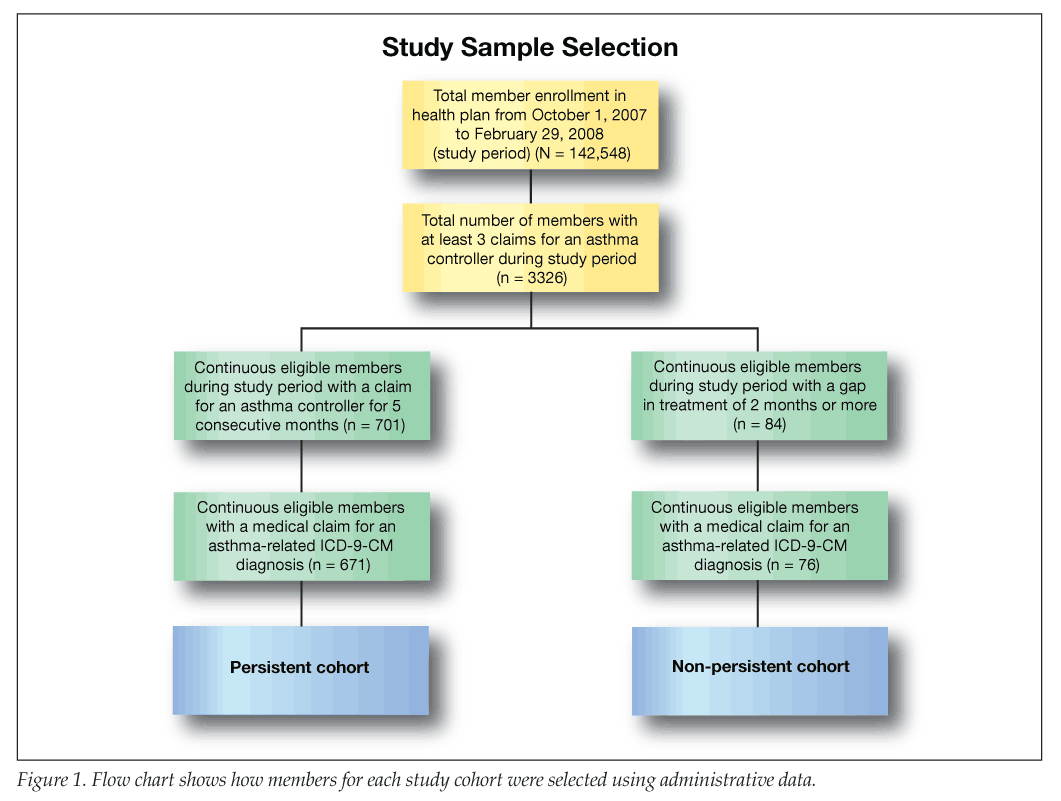
Health care service utilization and demographic data were obtained from the medical claims database. Utilization of health care services was measured by the percentage of members with asthma who had at least 1 claim for an inpatient visit, ED visit, home health visit, inpatient hospital day, physician office visit, or other outpatient visit. Place of service codes on the medical claims were used to identify the type of health service provided.
Health service expenditures of pharmacy, medical, and total costs (pharmacy plus medical) were reported as asthma-related or all-cause. Health care expenditures were determined to be asthma-related if those patient visits received ICD-9 diagnosis codes for asthma. Pharmacy expenditures were determined to be asthma-related if prescribed medications were identified as asthma maintenance medications. All-cause health care expenditures included pharmacy and medical costs incurred for any reason. Study participants residing in a zip code within 50 miles of the Louisville metropolitan area were classified as urban dwelling. To test for differences in health care expenditures and costs between the 2 groups, we conducted a 2-tailed t-test. An a level of .05 was used to test for statistical significance.
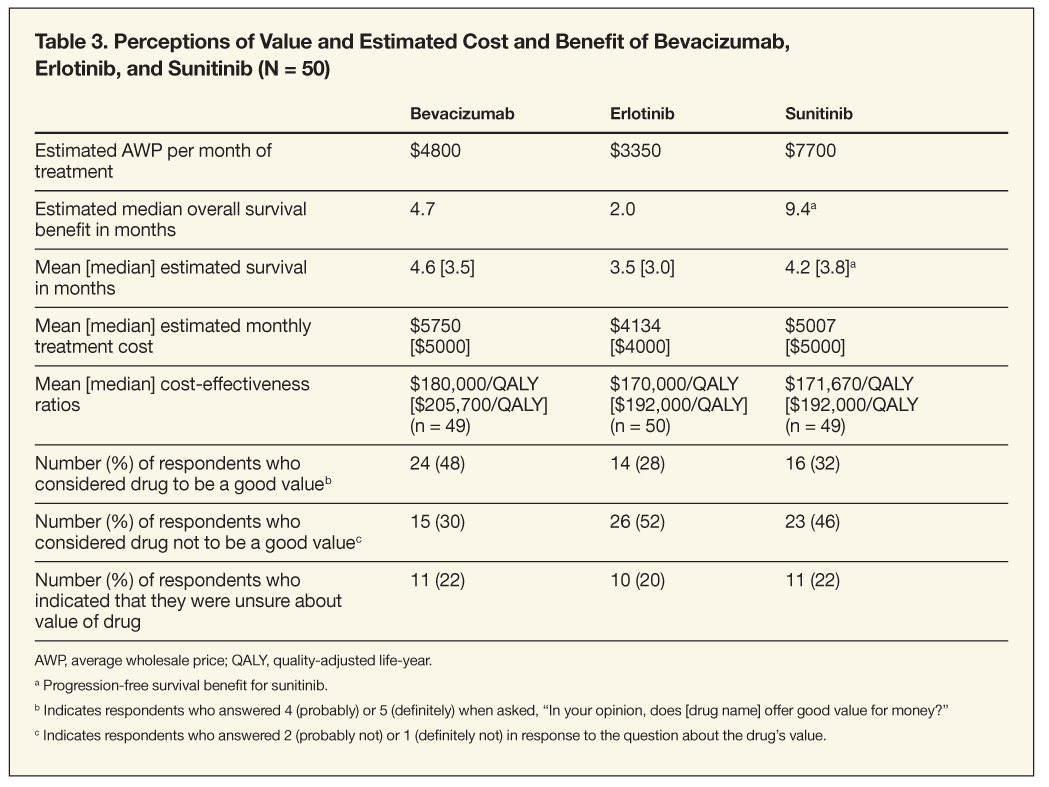
Results
A total of 747 members with asthma who were treated with a controller medication were identified. Of the 747 members, 671 (90%) persisted with maintenance therapy without any gaps during the 5 months of the study period. The remaining 76 (10%) were non-persistent with medication therapy. Demographics of the study sample are shown in Table 3. The groups were stratified into the following age ranges: 2 to 4 years, 5 to 9 years, 10 to 17 years, and 18 to 56 years. Non-persistence with controller therapy was more frequent among children and adolescents than among the adult group. The greatest incidence of non-persistence with controller medications was seen in the youngest age-group of 2 to 4 years. The incidence of non-persistence in this age-group was 15.8% compared with a rate of 9.7% for those who persisted with treatment. The distribution between urban and rural residences and between females and males was similar between the 2 groups.
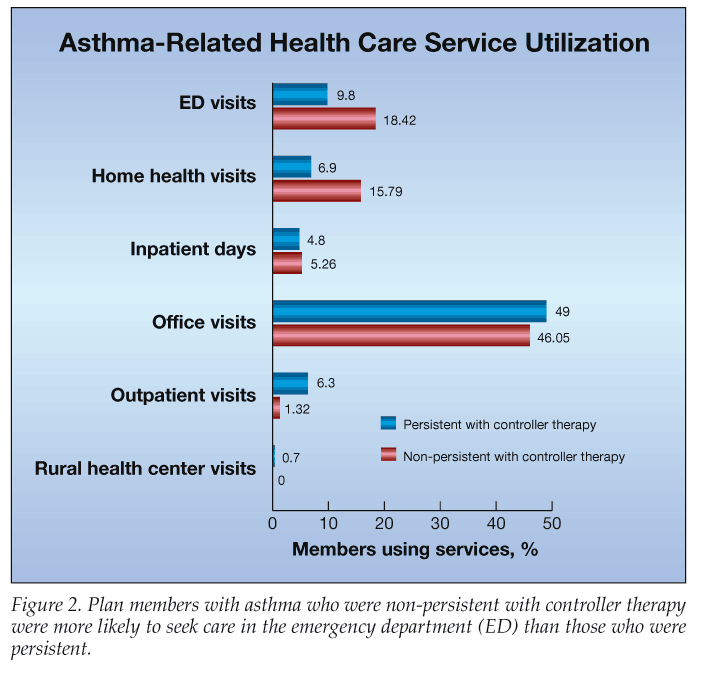
Asthma-related health care utilization accounted for 25% of all-cause medical costs. Non-persistent asthma patients had higher utilization rates for asthma-related ED visits and home health services than did those persistent with therapy (Figure 2). The persistent asthmatic cohort made more office visits, outpatient visits, and rural health center visits. With regard to inpatient days, the non-persistent cohort had slightly more visits per member than the persistent cohort, 0.4 versus 0.2 visits (Figure 3). All-cause–related health care utilization was higher in the non-persistent asthmatic cohort in all areas except office visits and outpatient visits. There was no difference between the cohorts in the number of rural health center visits (Figure 4).
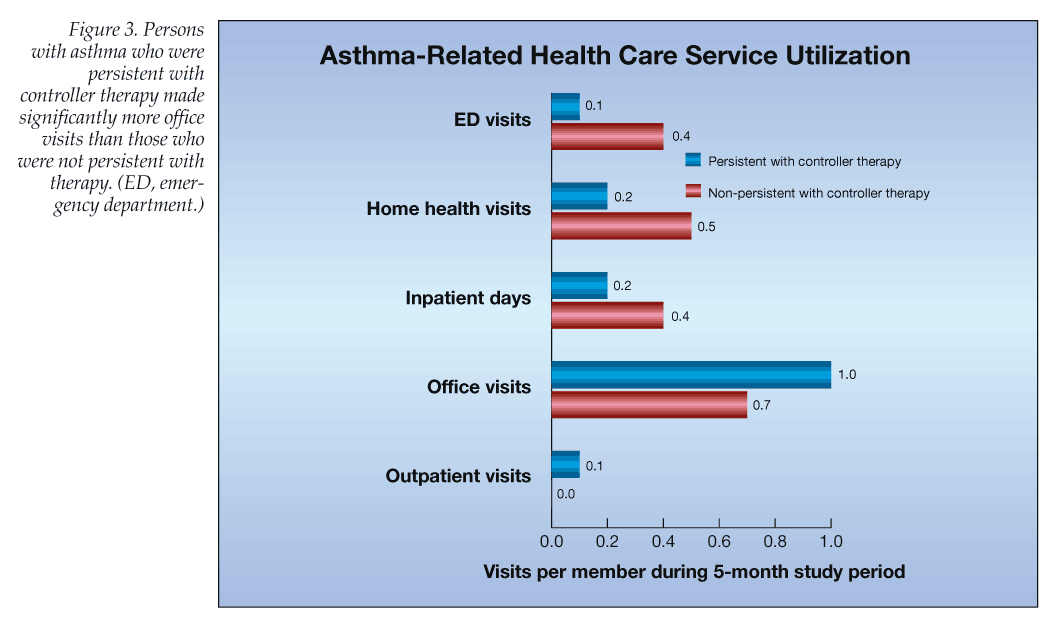
Mean asthma-related medical costs per member were greater in the non-persistent cohort than in the persistent cohort, $577.62 versus $323.03, respectively. Asthma-related pharmacy costs were significantly lower in the non-persistent cohort than in the persistent cohort: $494.80 versus $901.70 (P < .001). Total asthma-related health care costs were $1072.42 for the non-persistent cohort and $1224.73 for the persis- tent cohort (Table 4). Similar find- ings were observed for all-cause health care costs with greater medical costs incurred by the non-persistent asthma group than by the persistent asthma group. Average costs of health care services are listed in Table 5.
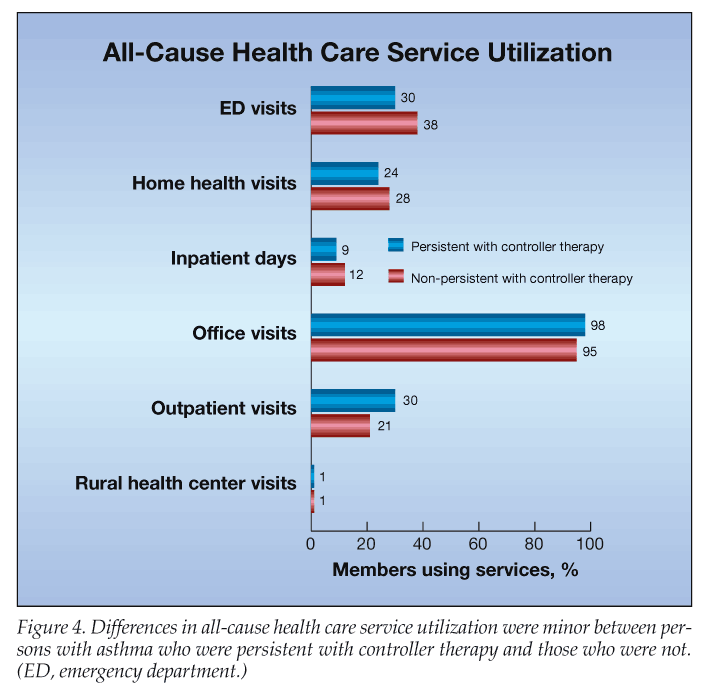
Discussion
The findings from this study suggest that 90% of members who were prescribed an asthma controller medication persisted with therapy during the 5 months. Our rate of persistence is remarkably higher than reports in the literature of other Medicaid populations. This could be attributed, in part, to the positive effect of our Asthma Disease Management Program. Passport Health Plan employs 2 asthma nurse managers who perform extensive outreach to members and providers.
The interventions of the program are based on improving member and provider adherence to the National Heart, Lung, and Blood Institute Guidelines for the Diagnosis and Management of Asthma,11 including promoting appropriate medication use and decreasing the number of unnecessary hospitalizations and ED visits.

Outreach to members includes educational mailings throughout the year on a variety of asthma-related topics. Depending on the identified level of need, members may also be contacted by phone or in person for counseling on self-management, available resources, and coordination of care. Practitioners receive written notification of their patients’ participation in the program. They also receive a quarterly report on service utilization and use of controller and reliever medications for high-risk asthma members.
The incidence of non-persistence to controller medications tended to be greater among younger members with asthma. Several studies have also reported the underuse of controller medications by Medicaid insured children with asthma. The incidence was even higher among children under the age of 4 years (79%).7 Low levels of parental education have been associated with underuse of controller medications in children either because of a lack of understanding about the benefits of preventative treatment or because of concerns about adverse effects. Consistent with previous reports, we found that non-persistent use of controller medications resulted in higher utilization rates for ED visits and hospitalizations. Consequently, asthma-related and all-cause medical costs per member were greater than those for members who maintained persistent use of controller medications. Although medical costs were greater for the non-persistent cohort, significant pharmacy cost differences contributed to lower total health care costs (pharmacy and medical) in this group.
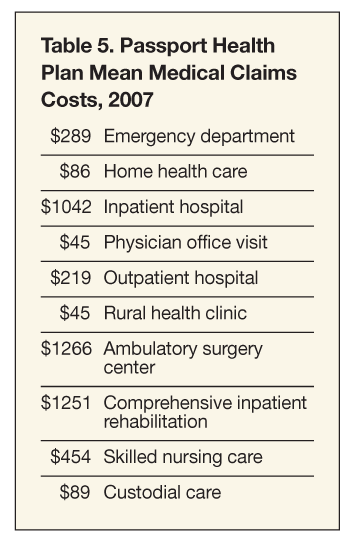
There are some limitations to our study. These include an inability to confirm that a filled prescription was actually taken as directed by the member. However, we established a standard of continuous use by requiring that a prescription claim be submitted in each month of the study period. Another limitation is the use of administrative data only to show a history of medication use. Administrative data do not capture the use of samples, which may have confounded the estimates of non-persistence. Although the health plan discourages the use of samples, it is possible for members to obtain samples from their provider. Because many members either have no copay or pay only a $1 copay, we suspect the use of samples is very limited. In addition, we did not examine the direct influence of demographic factors such as race, urban residence, and age on health service utilization and associated costs.
Future analysis will include a longer study period. The intent of the short duration for this study was to identify those members with a recent gap in therapy who could be targeted for interventions before a pattern of nonadherence was established. However, the 5-month study period may have been too short to account for seasonal variations that can influence use of asthma-related services. Moreover, the inclusion criterion of 3 consecutive months of controller medication use may underrepresent the rate of non-persistence with controller therapy. Fu-ture study may also incorporate the use of Current Procedural Technology (CPT) codes to establish treatment of persistent asthma. This will eliminate the need to use pharma- cy claims data to establish chronic treatment.
Conclusion
Non-persistent use of controller medications increases the utilization of health care services and medical costs associated with asthma. This study supports the need for targeted interventions, such as refill reminder programs, to address non-persistence to asthma controller medications. We are continuing to investigate the influence of specific controller medications on health care utilization and costs. These data will allow identification of opportunities to optimize appropriate drug therapy and improve outcomes. It remains clear that patient and parental education are key components of disease management approaches that emphasize the appropriate use of medications. Furthermore, health care providers, including primary care physicians and pharmacists, should be made aware of current asthma practice guidelines and their use in promoting adherence to treatment.
References:
References
1. American Lung Association Epidemiology and Statistics Unit. Trends in Asthma Morbidity and Mortality. American Lung Association; January 2009.
2. Kung HC, Hoyert DL, Xu JQ, Murphy SL; Division of Vital Statistics. Deaths: final data for 2005. National Vital Statistics Reports; Vol 56, No 10. Hyattsville, MD: National Center for Health Statistics; April 24, 2008.
3. Finkelstein JA, Lozano P, Farber HJ, et al. Underuse of controller medications among Medicaid-insured children with asthma. Arch Pediatr Adolsec Med. 2002;156:562-567.
4. Williams LK, Pladevall M, Xi H, et al. Relationship between adherence to inhaled cortico- steroids and poor outcomes among adults with asthma. J Allergy Clin Immunol. 2004;114:1288-1293.
5. Pappas G, Hadden WC, Kozak LJ, Fisher GF. Potentially avoidable hospitalizations: inequalities in rates between US socioeconomic groups. Am J Public Health. 1997;87:811-816.
6. Halfon N, Newacheck PW. Childhood asthma and poverty: differential impacts and utilization of health services. Pediatrics. 1993;91;56-61.
7. Finkelstein JA, Barton MB, Donahue JG, et al. Comparing asthma care for Medicaid and Non-Medicaid children in a health maintenance organization. Arch Pediatr Adolesc Med. 2000;154: 563-568.
8. Bosco LA, Gerstman BB, Tomita DK. Variations in the use of medication for the treatment of childhood asthma in the Michigan Medicaid population, 1980 to 1986. Chest. 1993;104:1727-1732.
9. America’s Health Rankings: Kentucky. Unit- ed Health Foundation; 2008. http://www. americashealthrankings.org/2008/ky.pdf/pdfs.
10. Many Kentuckians Live in Poverty. Commu- nity Action Kentucky; 2008. http://www. communityactionky.com/PovertyinKentucky/ KentuckiansinPoverty/tabif/445/Default.aspx.
11. National Heart, Lung, and Blood Institute. Guidelines for the Diagnosis and Management of Asthma. U.S. Department of Health and Human Services; 2007. http://www.nhlbi.gov/ guidelines/asthma. Accessed March 23, 2009.